
Board games are tabletop games that typically use pieces. These pieces are moved or placed on a pre-marked board and often include elements of table, card, role-playing, and miniatures games as well.

Hatshepsut was the Great Royal Wife of Pharaoh Thutmose II and the fifth Pharaoh of the Eighteenth Dynasty of Egypt, ruling first as regent, then as queen regnant from c. 1479 BC until c. 1458 BC. She was Egypt's second confirmed queen regnant, the first being Sobekneferu/Nefrusobek in the Twelfth Dynasty.
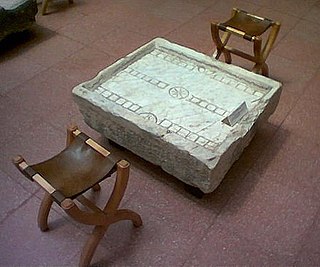
Ludus duodecim scriptorum, or XII scripta, was a board game popular during the time of the Roman Empire. The name translates as "game of twelve markings", probably referring to the three rows of 12 markings each found on most surviving boards. The game tabula is thought to be a descendant of this game, and both are tables games as is modern backgammon.
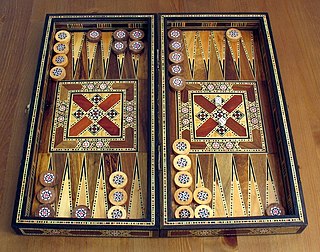
Tables games are a class of board game that includes backgammon and which are played on a tables board, typically with two rows of 12 vertical markings called points. Players roll dice to determine the movement of pieces. Tables games are among the oldest known board games, and many different varieties are played throughout the world. They are called 'tables' games because the boards consist of four quadrants or 'tables'. The vast majority are race games, the tables board representing a linear race track with start and finish points, the aim being to be first to the finish line, but the characteristic features that distinguish tables games from other race games are that they are two-player games using a large number of pieces, usually fifteen per player.
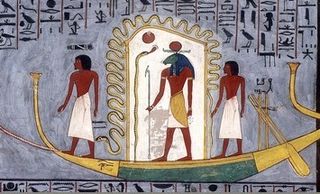
In Egyptian mythology, the name Mehen, meaning 'coiled one', referred to a mythological snake-god and to a board game.

Senet or senat is a board game from ancient Egypt that consists of ten or more pawns on a 30-square playing board. The earliest representation of senet is dated to c. 2620 BCE from the Mastaba of Hesy-Re, while similar boards and hieroglyphic signs are found even earlier, including in the Levant in the Early Bronze Age II period. Even though the game has a 2,000-year history in Egypt, there appears to be very little variation in terms of key components. This can be determined by studying the various senet boards that have been found by archaeologists, as well depictions of senet being played throughout Egyptian history on places like tomb walls and papyrus scrolls. However, the game fell out of use following the Roman period, and its original rules are the subject of conjecture.
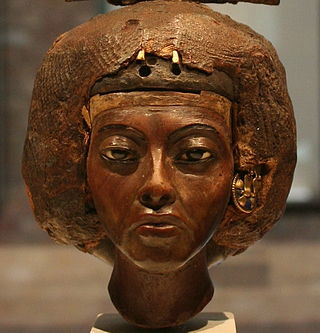
Tiye was the Great Royal Wife of the Egyptian pharaoh Amenhotep III, mother of pharaoh Akhenaten and grandmother of pharaoh Tutankhamun; her parents were Yuya and Thuya. In 2010, DNA analysis confirmed her as the mummy known as "The Elder Lady" found in the tomb of Amenhotep II (KV35) in 1898.
The 31st century BC was a century that lasted from the year 3100 BC to 3001 BC.

Khafre or Khafra, also known as Khephren or Chephren, was an ancient Egyptian pharaoh of the Fourth Dynasty during the Old Kingdom. He was the son of Khufu and the successor of Djedefre.

Narmer was an ancient Egyptian pharaoh of the Early Dynastic Period. He was the successor to the Protodynastic king Ka. Many scholars consider him the unifier of Egypt and founder of the First Dynasty, and in turn the first king of a unified Egypt. He also had a prominently noticeable presence in Canaan, compared to his predecessors and successors. A majority of Egyptologists believe that Narmer was the same person as Menes. Neithhotep is thought to be his queen consort or his daughter.

The Royal Game of Ur is a two-player strategy race board game of the tables family that was first played in ancient Mesopotamia during the early third millennium BC. The game was popular across the Middle East among people of all social strata, and boards for playing it have been found at locations as far away from Mesopotamia as Crete and Sri Lanka. One board, held by the British Museum, is dated to c. 2600 – c. 2400 BC, making it one of the oldest game boards in the world.
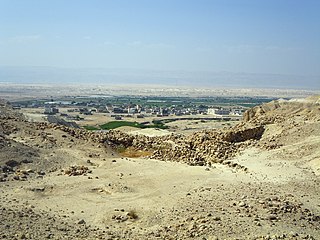
Bab edh-Dhra is the site of an Early Bronze Age city located near the Dead Sea, on the south bank of Wadi Kerak with dates in the EB IB, EB II, EB III and EB IVA. Bab edh-Dhra was discovered in 1924 on an expedition led by William F. Albright.

Numeira is an archaeological site in Jordan near the southern Dead Sea. The site has substantial Early Bronze Age remains.
Race game is a large category of board games, in which the object is to be the first to move all one's pieces to the end of a track. This is both the earliest type of board game known, with implements and representations dating back to at least the 3rd millennium BC in Egypt, Iraq, and Iran; and also the most widely dispersed: "all cultures that have games at all have race games". Race games often use dice to decide game options and how far to move pieces.
The ancient Egyptian Game piece (hieroglyph), also a Token, or the general term for any gaming-gambling piece, Draughtsman is an ancient hieroglyph. Gaming pieces were certainly required in predynastic times, as the cultural creation of games and entertainment has a long history in most cultures. An ivory-piece lion is known from the Old Kingdom of ancient Egypt; the set contains three lions, and three dog tokens of ivory.

The history of games dates to the ancient human past. Games are an integral part of all cultures and are one of the oldest forms of human social interaction. Games are formalized expressions of play which allow people to go beyond immediate imagination and direct physical activity. Common features of games include uncertainty of outcome, agreed upon rules, competition, separate place and time, elements of fiction, elements of chance, prescribed goals and personal enjoyment.

Hounds and jackals or dogs and jackals is the modern name given to an ancient Egyptian tables game that is known from several examples of gaming boards and gaming pieces found in excavations. The modern game was discovered by Howard Carter, who found one complete gaming set in a Theban tomb from the reign of ancient Egyptian pharaoh Amenemhat IV that dates to the 12th Dynasty. The latter game set is one of the best preserved examples and is today in the Metropolitan Museum of Art in New York. He called it "Hounds contra Jackals". Another, less often used modern name is "fifty-eight holes".















